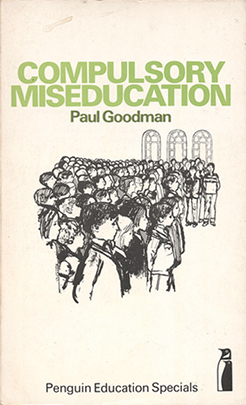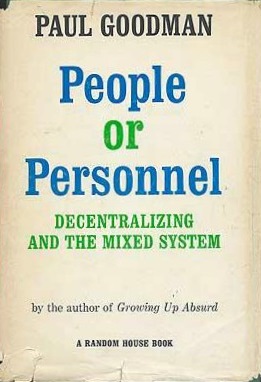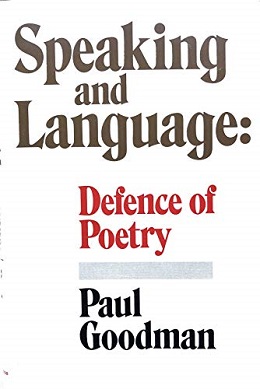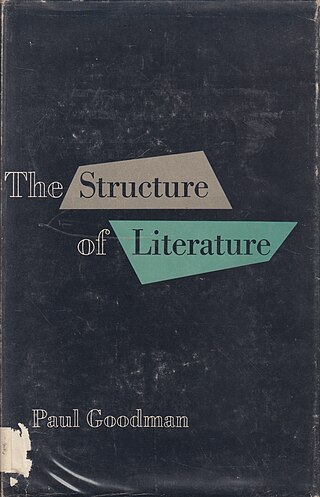
Compulsory Miseducation is a critique of American public schools written by Paul Goodman and published by Horizon Press in 1964. Already established as a social critic of American society and the role of its youth in his previous book Growing Up Absurd (1960), Goodman argues in Compulsory Miseducation against the necessity of schools for the socialization of youth and recommends their abolition. He suggests that formal education lasts too long, teaches the wrong social class values, and increasingly damages students over time. Goodman writes that the school reflects the misguided and insincere values of its society and thus school reformers should focus on these values before schools. He proposes a variety of alternatives to school including no school, the city or farm as school, apprenticeships, guided travel, and youth organizations. Reviewers complimented Goodman's style and noted his deliberate contrarianism, but were split on the feasibility of his proposals. Goodman's book was a precursor to the work of deschooling advocate Ivan Illich.

Growing Up Absurd is a 1960 book by Paul Goodman on the relationship between American juvenile delinquency and societal opportunities to fulfill natural needs. Contrary to the then-popular view that juvenile delinquents should be led to respect societal norms, Goodman argued that young American men were justified in their disaffection because their society lacked the preconditions for growing up, such as meaningful work, honorable community, sexual freedom, and spiritual sustenance.

Communitas: Means of Livelihood and Ways of Life is a 1947 book on community and city planning by Percival and Paul Goodman. Presented as an illustrated primer on how city planning affects socioeconomic order and citizens' empowerment to better their communities, the book reviews historical and modern approaches to urban planning before proposing three of the Goodmans' own provocative community paradigms.

The Community of Scholars is a 1962 book about higher education by Paul Goodman with his observations on its function and proposals for its future.

New Reformation: Notes of a Neolithic Conservative is a 1970 book of social commentary by Paul Goodman best known as his apologia pro vita sua before his death two years later.

Kafka's Prayer is a 1947 book-length analysis of the novelist Franz Kafka and his works by Paul Goodman. Using Freudian and Reichian psychoanalysis, Goodman assesses the philosophical and religious significance of Kafka's aphoristic statements and three novels. He levels an anarchist societal critique against social institutions borne from neuroticism. Goodman used the book, published by Vanguard Press, to grapple with the religious implications of psychoanalysis and transition from a career writing on Jewish concerns to a period that would culminate in his collaboration on the founding work of the gestalt therapy movement.

The May Pamphlet is a collection of six anarchist essays written and published by Paul Goodman in 1945. Goodman discusses the problems of living in a society that represses individual instinct through coercion. He suggests that individuals resist such conditions by reclaiming their natural instincts and initiative, and by "drawing the line", an ideological delineation beyond which an individual should refuse to conform or cooperate with social convention. While themes from The May Pamphlet—decentralization, peace, social psychology, youth liberation—would recur throughout his works, Goodman's later social criticism focused on practical applications rather than theoretical concerns.

People or Personnel is a critique of centralized power written by Paul Goodman and published by Random House in 1965.

Speaking and Language: Defence of Poetry is a book of criticism by Paul Goodman that blames academic, structured approaches to linguistics for diminishing the role of creativity and spontaneity in speaking and human nature.

Little Prayers and Finite Experience is a book of prose and poetry by Paul Goodman.

Making Do is a 1963 novel written by Paul Goodman and published by Macmillan.

The Structure of Literature is a 1954 book of literary criticism by Paul Goodman. The published version of Goodman's doctoral dissertation in the humanities, the book proposes a mode of formal literary analysis that digests a literary work into structural elements based on the reader's experience and recombines those parts to explain the work as a whole. The book analyzes several literary works as examples with close analysis and genre discussion.

Paul Goodman described himself as a man of letters but foremost a poet. He published several poetry collections in his life, including The Lordly Hudson (1962), Hawkweed (1967), North Percy (1968), and Homespun of Oatmeal Gray (1970). His Collected Poems (1973) were published posthumously.
Taylor Stoehr (1931–2013) was an American professor and author. He edited several volumes of Paul Goodman's work as his literary executor.
This is a list of works by Murray Bookchin (1921–2006). For a more complete list, please see the Bookchin bibliography compiled by Janet Biehl.

The Lordly Hudson is a poem and 1962 book of collected poetry by Paul Goodman.
"The Politics of Being Queer" is a 1969 essay by Paul Goodman on the connection between his bisexuality and his personal politics. It is noteworthy for its role in reclaiming the word "queer". Originally published as "Memoirs of an Ancient Activist", Goodman revised the essay, which was retitled and published posthumously.
Parents' Day is a 1951 novel by Paul Goodman. Written as autobiographical fiction based on the author's experiences teaching at the upstate New York progressive boarding school Manumit during the 1943–1944 year, the book's narrator grapples with his homosexuality and explores a series of sexual attractions and relationships that culminates in his being fired by the school. Goodman wrote the novel as part of a Reichian self-analysis begun in 1946 to better understand his own life. He struggled to find a publisher and ultimately self-published through a friend's small press. Reviewers remarked on unease in Goodman's sexual revelations, lack of self-awareness, and lack of coherence in the text. Parents' Day sold poorly and has been largely forgotten, save for some recognition as an early gay American novel.
Prior to his career in social criticism, the American writer Paul Goodman had a prolific career in avant-garde literature, including some 16 works for the stage. His plays, mostly written in the 1940s, were typically experimental. Their professional productions were either unsuccessful or flopped, including the three productions staged with The Living Theatre in the 1950s and one with The American Place Theatre in 1966. His lack of recognition as a litterateur in the 1950s helped drive him to his successful career in social criticism in the 1960s.

Paul Goodman was an American writer and public intellectual best known for his 1960s works of social criticism. Goodman was prolific across numerous literary genres and non-fiction topics, including the arts, civil rights, decentralization, democracy, education, media, politics, psychology, technology, urban planning, and war. As a humanist and self-styled man of letters, his works often addressed a common theme of the individual citizen's duties in the larger society, and the responsibility to exercise autonomy, act creatively, and realize one's own human nature.















